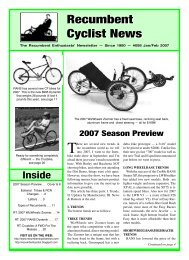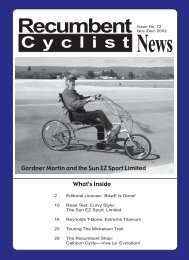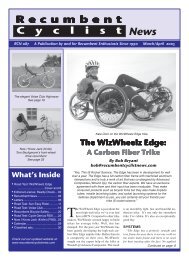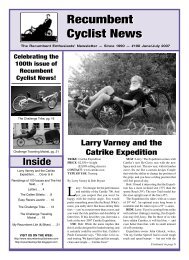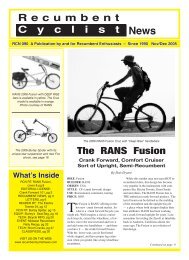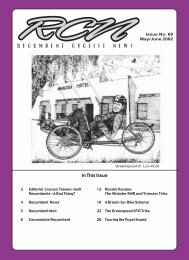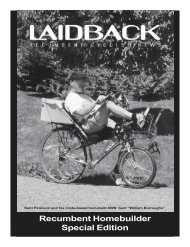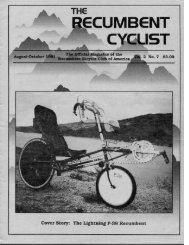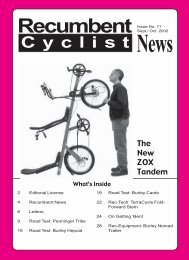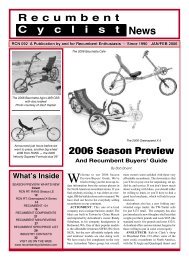C y c l i s t Recumbent - Steve Briggs
C y c l i s t Recumbent - Steve Briggs
C y c l i s t Recumbent - Steve Briggs
Create successful ePaper yourself
Turn your PDF publications into a flip-book with our unique Google optimized e-Paper software.
Dialing-In a Choice of Muscles<br />
The Rotor has an adjustment called the<br />
“regulation point” that can be set when the<br />
cranks are installed. You measure the position<br />
of the regulation point with the aid of reference<br />
marks etched into the Rotor. This setting<br />
controls where you get the most leverage in<br />
the spin cycle.<br />
The choice of regulation point makes a surprising<br />
difference in how the Rotors feel. It’s<br />
almost as if this setting lets you dial in which<br />
muscle groups you prefer to use. When the<br />
regulation point was set toward the longer tick<br />
marks, I tended to use my calves more and<br />
pulled more on the cranks. The overall effect<br />
was that it was better for climbing hills. But<br />
this position also tended to make me spin out<br />
more easily, causing me to ride the bigger chain<br />
rings more.<br />
Most riders will want to set the regulation<br />
point in the recommended middle position, or<br />
perhaps just a tad toward the longer marks.<br />
Chain rings<br />
Rotor chain rings are custom made to fit<br />
around the large cam at the center of the crank.<br />
Rotor has rings available in sizes from an inner<br />
of 26 to an outer of 63 teeth. The rings are<br />
lightweight, well-machined, and beautifully<br />
anodized. The outer rings have pins and ramps<br />
to make for smooth shifting. Crank arms come<br />
in lengths from 165-180 mm.<br />
Another Gizmo to Break?<br />
One of the most important questions for anyone<br />
getting ready to spend big bucks on some<br />
new gizmo is whether or not the thing is going<br />
to hold up over time. Indeed, Rotor cranks are<br />
more complicated than traditional cranks. In<br />
addition to the usual gears and bottom bracket<br />
bearings, there’s now a cam and a couple of<br />
pivots to turn and wear.<br />
The workmanship on the Rotor is top<br />
drawer. When I asked Howie Cohen of<br />
RotorUSA what sort of things seem to break<br />
on the Rotors, he made it seem like he’s the<br />
Maytag repairman who just sits around playing<br />
solitaire all day: he said customers just<br />
aren’t coming back with problems. Rotor<br />
The Bike Rack<br />
Let us build the recumbent of your dreams<br />
<strong>Recumbent</strong>s from:<br />
• Bacchetta<br />
• RANS<br />
• Easy Racers<br />
• HP Velotechnik<br />
• Burley<br />
• Haluzak<br />
• Penninger<br />
• ICE Trice<br />
2930 Campton Hill Rd.<br />
St. Charles, Illinois 60175<br />
cranks come with a two-year warranty.<br />
When I pressed Howie about the potential<br />
failure points on the Rotor he pointed out there<br />
are a few o-rings that can wear out, and that –<br />
like any bottom bracket — the bearings may<br />
eventually need to be replaced.<br />
You’ll find that routine maintenance is a bit<br />
more complex than standard cranks. You need<br />
to put a drop of oil on the o-rings every time<br />
you lube the chain, and check to make sure<br />
the “regulation point” hasn’t slipped. Once a<br />
year or so you need to squirt some grease at<br />
the main bearings.<br />
Overall<br />
The Rotor crank is one of the most exciting<br />
innovations in cycling I’ve seen in recent years,<br />
on a par with the improvements in tires, gearing,<br />
and aerodynamics that have contributed<br />
to the evolution of bicycle design. These things<br />
are the biggest improvement in riding I’ve<br />
experienced since I switched to a Bacchetta<br />
Aero.<br />
From everything I can tell the product performs<br />
as advertised: it improves your speed,<br />
helps you climb hills, and reduces knee-pain<br />
— what could be better for ‘bents?<br />
Do I wish they were cheaper? Of course!<br />
But the gain in performance is comparable to<br />
upgrading to a new bike. So, if you’ve already<br />
done everything you can to maximize performance,<br />
the price is small for the leg up in performance.<br />
Info<br />
Rotor Cranks cost $665 (Cromoly) - $865 (Titanium)<br />
and have a 30 day satisfaction guarantee.<br />
The cranks can be built with different<br />
sized crank arms and chainrings.<br />
Why Buy This Crank?<br />
Better performance, healthier on the joints.<br />
For<br />
Knee pain relief<br />
Better hill climbing<br />
Increased speed<br />
Home of Creative Mobility<br />
Mobility Solution Specialists:<br />
• Hand Powered Bikes<br />
• Wheelchairs<br />
• Trikes<br />
• Custom Fit is our Specialty<br />
• Full Service Shop<br />
We ship world wide<br />
Against<br />
Cost<br />
Adds 1 pound to the bike<br />
Greater complexity<br />
Contact<br />
Rotor USA: Howie Cohen<br />
Email: howie@rotorbike.com<br />
Tel: 970/389-7082<br />
Web: http://rotorcranksusa.com/<br />
Credits<br />
Matt Schneps, when not out riding, directs<br />
SportSmarts, a science education initiative of<br />
the Harvard-Smithsonian Center for Astrophysics<br />
in Cambridge, MA. All photographs<br />
by the author unless noted. ◆<br />
Craig Ripley Studios<br />
Featuring the Spirit of Cycling Art Prints<br />
<strong>Recumbent</strong> Art Prints<br />
Custom Cycling Portraits<br />
See us online at www.craigripley.com<br />
The Bacchetta Strada<br />
Call us at 1-800.711.BIKE<br />
www.thebikerack.com<br />
Sept./Oct. 2004 27 27<br />
27



